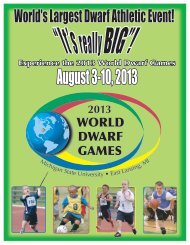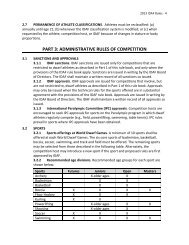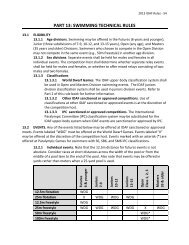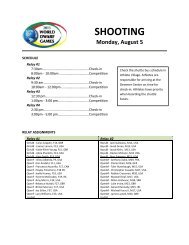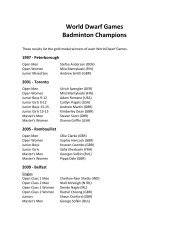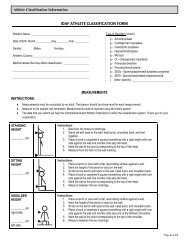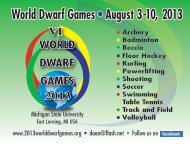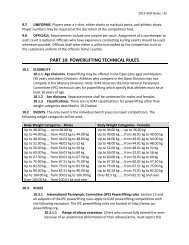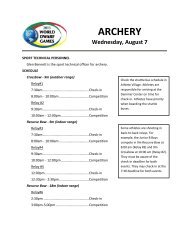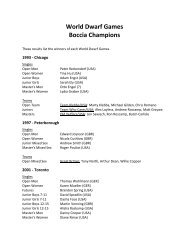Create successful ePaper yourself
Turn your PDF publications into a flip-book with our unique Google optimized e-Paper software.
<strong>2013</strong> IDAF <strong>Rules</strong> ‐ 23<br />
be in overall charge of the tournament. Each umpire shall be in charge of a match, the<br />
court, and its immediate surrounds. Service judges and line judges shall be used<br />
whenever practical.<br />
5.8.2 Qualifications. The referee and umpire shall be certified by a national or<br />
international governing body for badminton. The service judges and line judges shall<br />
have experience at those positions.<br />
5.8.3 Officials uniforms. The badminton officials shall wear either a uniform<br />
provided by the competition host or the customary uniform of the official's home<br />
country. Scoring table personnel and other assistants shall wear uniforms specified by<br />
the competition host.<br />
PART 6: BASKETBALL TECHNICAL RULES<br />
6.1 ELIGIBILITY<br />
6.1.1 Age divisions. <strong>Basketball</strong> may be offered for the Junior A (7‐11 years), Junior B<br />
(12‐15 years), and Open (any age) Divisions. Players who choose to compete in the Open<br />
Division may not also compete in the Junior A or Junior B Division.<br />
6.1.2 Gender. The competition host may determine whether separate competition<br />
divisions are held for males and females. When divisions by sex are not offered, team<br />
rosters may include any combination of all males, all females, or mixed‐gender.<br />
6.1.3 Classifications. There are no IDAF classifications for basketball.<br />
6.1.4 Team rosters.<br />
6.1.4.1 Number of players. There shall be no fewer than 9 and no more than<br />
12 players on a team. A team may not have alternates above the 12 player limit.<br />
6.1.4.2 Submitting team rosters. The competition host shall establish a<br />
process and deadlines for submitting team rosters.<br />
6.1.4.3 Mixed‐country teams. At <strong>World</strong> <strong>Dwarf</strong> <strong>Games</strong>, athletes whose<br />
countries do not have enough players to field a complete team may request to<br />
play on a mixed‐country team. The competition host shall facilitate the<br />
formation of mixed country‐teams.<br />
6.2 EVENTS. <strong>Basketball</strong> competition shall consist of 5‐on‐5 play.<br />
6.3 RULES<br />
6.3.1 FIBA rules. Rule One‐The Game, Rule Two‐Court and Equipment, Rule Three‐<br />
Teams, Rule Four‐Playing Regulations, Rule Five‐Violations, Rule Six‐Fouls, and Rule<br />
Seven‐General Provisions of the current edition of the International <strong>Basketball</strong><br />
Federation (FIBA) Official <strong>Basketball</strong> <strong>Rules</strong> (http://www.fiba.com) shall apply with the<br />
following exceptions.<br />
6.3.2 Exceptions<br />
6.3.2.1 Court. If regulation‐size FIBA courts are not available, a USA high<br />
school or collegiate basketball court with a rectangular key and a 19 ft‐9 in<br />
3‐point line may be substituted. When possible, baskets with a goal height of 8<br />
feet should be used for Junior A competition.
<strong>2013</strong> IDAF <strong>Rules</strong> ‐ 24<br />
6.3.2.2 <strong>Basketball</strong>. An international size 6 (women's size) basketball,<br />
circumference 72.39 cm (28.5‐29.0 in), weight 496‐553 grams (18‐20 oz), shall be<br />
used for Open Division basketball games. An international size 5 (junior size)<br />
basketball, circumference 69‐70 cm (27.25‐27.75 in), weight 470‐500 grams<br />
(14‐16 oz), shall be used for the Junior A and Junior B Divisions.<br />
6.3.2.3 Pre‐game warm‐up. The duration of the pre‐game warm‐up period<br />
shall be a minimum of 10 minutes prior to the start of the game.<br />
6.3.2.4 Playing time. A basketball game shall consist of four quarters of 8<br />
minutes each for the Open Division, and four quarters of 6 minutes each for the<br />
Junior A and Junior B Divisions. The clock will be run continuously except for the<br />
last minute of the fourth quarter during which the clock will stop upon the<br />
officials whistle, indicating one or more of the following:<br />
A foul (personal or technical)<br />
A jump ball<br />
A floor violation<br />
An unusual delay<br />
A time‐out or other emergency<br />
A regular time‐out<br />
6.3.2.5 Intermissions. There shall be a one‐minute intermission after the<br />
first and third quarters, and a five‐minute intermission at half‐time after the<br />
second quarter.<br />
6.3.2.6 Overtime. If the score is tied at the end of the fourth quarter,<br />
2‐minute overtime periods will be played until a winner is determined. There<br />
shall be a one‐minute intermission before each overtime period. Each team shall<br />
be given one sixty‐second time‐out in addition to any carry‐over time‐outs. The<br />
overtime period will begin with a jump ball.<br />
6.3.2.7 Point spread. If the point margin is 18 points or more in the fourth<br />
quarter, there shall be a continuous clock for the remainder of the game. In this<br />
case, the clock shall be stopped only for free throws and time outs.<br />
6.3.2.8 Time limit under the basket. An offensive player may occupy the<br />
space in the key (paint) for a maximum of 5 seconds.<br />
6.3.2.9 Advance into front court. A team has 10 seconds to advance the ball<br />
into front court. A new count will begin if stoppage of play has occurred before<br />
the ball is advanced past the center line. Failure to advance into the front court<br />
within this time frame will result in the offensive team turning possession over to<br />
the opposing team and play resuming at mid court.<br />
6.3.2.10 Shot clock. A shot clock will not be used at <strong>World</strong> <strong>Dwarf</strong> Game<br />
events.<br />
6.3.2.11 Jump ball. A jump ball will be used at the beginning of the first<br />
quarter and all overtime periods. Alternating possession will be used for the<br />
remainder of the game. Players cannot move onto or around the circle until the<br />
ball leaves the officials hand upon a jump ball.
<strong>2013</strong> IDAF <strong>Rules</strong> ‐ 25<br />
6.3.2.12 Team control. Team control applies only during a live ball inbounds,<br />
thus, team control does not exist on a throw‐in.<br />
6.3.2.13 Throw‐ins. During a front‐court throw‐in, the ball may be thrown<br />
anywhere on the court. At no time can the ball be thrown over the backboard on<br />
a throw‐in.<br />
6.3.2.14 Substitutions. During play, substitutes must always be beckoned in<br />
by an official. During a free throw, substitutions are allowed before the last<br />
attempt in the sequence or after the last free throw in the sequence if it was<br />
successful. Substitutions can also be made during a time‐out.<br />
6.3.2.15 Time‐outs. Each team shall be entitled to two 60‐second time‐outs in<br />
the first half and three 60‐second time‐outs in the second half. Time‐outs are<br />
granted at the request of any player or coach while in team control or during any<br />
dead ball situation. Time‐outs may be granted during free throws. In addition to<br />
one time‐out granted per overtime period, unused time‐outs will carry‐over to<br />
overtime period(s).<br />
6.3.2.16 Foul shots. A maximum of 5 players can occupy the lane spaces. The<br />
first space on either side of the lane must be occupied by the defense. No player<br />
shall occupy the fourth space on either side of the lane. During a foul shot,<br />
violations by the offense team shall be called immediately. Violations by the<br />
defensive team will be ignored if the free throw is successful. When shooting a<br />
free throw, players will have 10 seconds to release the ball. The lane area cannot<br />
be entered until the ball leaves the shooters hands; the shooter cannot enter the<br />
lane until the ball has hit the ring. Should the shooter fail to hit the ring<br />
possession will automatically be given to the opposing (defending) team on the<br />
side line, in line with the free throw line.<br />
6.3.2.17 Falling to floor. A travelling violation will occur if a player with the<br />
ball slides or falls to the floor.<br />
6.3.2.18 Closely guarded. The closely guarded violation will be enacted when<br />
the player is in the front‐court only.<br />
6.3.2.19 Front court/back court status. Front court status is achieved once<br />
the player is no longer in contact with the back court and is in contact with the<br />
front court, unless during a dribble, when both feet must be in the front court. A<br />
player that is straddling the centerline, but is not dribbling, is considered to have<br />
back court status.<br />
6.3.2.20 Penalty (bonus). A team will be granted 1+1 penalty foul shots upon<br />
their opponent’s seventh team foul. Teams will be granted two penalty foul<br />
shots upon the commission of their opponent’s tenth team foul.<br />
6.3.2.21 Technical fouls. Technical fouls may be issued for both contact and<br />
non‐contact violations during a dead ball and non‐contact violations during a live<br />
ball. Opponents will be issued two foul shots, with play resuming at the point of<br />
interruption. Intentional technical fouls will be called upon contact by a player<br />
during a dead ball and will result in two foul shots by the opponent, with the ball<br />
put back into play at the division line. In the event of a flagrant technical foul,<br />
the violating player will be immediately ejected and the opposing team will
<strong>2013</strong> IDAF <strong>Rules</strong> ‐ 26<br />
receive two foul shots. The ball will be placed at the division line to resume play.<br />
Technical fouls called on coaches or bench personnel will count towards the<br />
team foul count. The coach will lose his/her coaching box privilege if he/she<br />
commits a technical foul.<br />
6.3.2.22 Unsportsmanlike/flagrant foul. In the event of an<br />
unsportsmanlike/flagrant foul, the opposing team will receive two or three foul<br />
shots (depending on location of violation). In the event of a made basket, the<br />
basket will be scored and the team will receive two foul shots and possession.<br />
After completion of the foul shots, the throw‐in will occur at the spot closest to<br />
the infraction.<br />
6.3.2.23 Cancelled foul shot/field goal. In the event of a cancelled foul shot<br />
or field goal, the resulting throw‐in will occur from the end line.<br />
6.4 COMPETITION PROCEDURES<br />
6.4.1 Practice opportunities. Players shall have a minimum of 10 minutes pre‐game<br />
warm‐up on the competition court prior to the start of the game. The competition host<br />
shall determine the schedule and location of additional practice time opportunities.<br />
6.4.2 Entry limit. At <strong>World</strong> <strong>Dwarf</strong> <strong>Games</strong>, each country shall be allowed to enter as<br />
many teams as desired into each division of the basketball tournament. Countries that<br />
enter more than one team within a division shall designate one team “Team A,” the next<br />
“Team B,” etc.<br />
6.4.3 Tournament format. The competition host shall determine the tournament<br />
format (e.g., pool play, bracket play).<br />
6.4.4 Check‐in procedures. The competition host shall determine check‐in<br />
procedures.<br />
6.5 FACILITIES. As noted in Section 6.3 above, either FIBA, USA collegiate, or USA high<br />
school basketball courts may be used in IDAF basketball competitions.
<strong>2013</strong> IDAF <strong>Rules</strong> ‐ 27<br />
6.6 EQUIPMENT. As noted in section 6.3 above, an international size 6 (women's size)<br />
basketball, circumference 72.39 cm (28.5‐29.0 in), weight 496‐553 grams (18‐20 oz), shall be<br />
used for Open Division basketball games. An international size 5 (junior size) basketball,<br />
circumference 69‐70 cm (27.25‐27.75 in), weight 470‐500 grams (14 to 16 oz), shall be used for<br />
the Junior A and Junior B Divisions.<br />
6.7 UNIFORMS<br />
6.7.1 Uniforms. Player uniforms will consist of a basketball jersey (or T‐shirt), shorts,<br />
and athletic shoes. Teams are required to wear a consistent shirt color amongst all<br />
players. Any shirts worn underneath the uniform must be the same color as the uniform<br />
shirt. If the players on a single team are not consistent with the colors of their T‐shirts,<br />
the players on the team will be asked to wear identically colored pinnies/vests to be<br />
provided by the competition host.<br />
6.7.2 Player numbers. Each player’s shirt shall display a clearly visible unique number<br />
on both the front and back. Whenever possible, the player numbers shall be selected<br />
from 0‐5, 10‐15, 20‐25, 30‐35, 40‐45, and 50‐55, enabling officials to use their fingers to<br />
identify players.<br />
6.8 OFFICIALS. Rule Eight (Officials, Table Officials, Commissioner: Duties and Powers) of the<br />
FIBA rules (http://www.fiba.com) shall serve as guidelines for officiating at IDAF basketball<br />
competitions.<br />
6.8.1 Minimum number. <strong>Basketball</strong> games shall be officiated by a minimum of two<br />
certified game officials. In addition, there shall be a minimum of two people at the<br />
scorer’s table, one to manage the clock and the possession arrow, and the other to<br />
record the score, fouls, time‐outs in the score book throughout the game. A court<br />
marshal should be assigned to each court, with responsibility for ensuring that all games<br />
start on time and that all teams have checked‐in promptly at the basketball check‐in<br />
table.<br />
6.8.2 Qualifications. The two game officials shall be certified by a national or<br />
international governing body for basketball. Whenever possible, they shall be<br />
independent of the host organization and of the players in the game. The scoring table<br />
personnel should be familiar with basketball rules, particularly clock procedures,<br />
possession arrow procedures, and foul bonus procedures.<br />
6.8.3 Officials uniforms. The two game officials shall wear either a uniform provided<br />
by the competition host or the customary uniform of the official's home country.<br />
Scoring table personnel and the court marshal should wear uniforms specified by the<br />
competition host.<br />
6.8.4 Officials briefings. At least 45 minutes prior to the start of the tournament, the<br />
tournament director shall meet with all officials for a rules briefing. The agenda shall<br />
include any rules that might be unique to dwarf basketball and the <strong>World</strong> <strong>Dwarf</strong> <strong>Games</strong>.<br />
The tournament director shall provide guidelines for how stringently to call the rules<br />
during the course of play. It is suggested that the rules be enforced tightly in the Open<br />
and Junior B Divisions so as to ensure safe play and minimize conflicts between players.<br />
In the Junior A division, participants are still developing their skills, so some leniency<br />
should be provided in the enforcement of the rules.
<strong>2013</strong> IDAF <strong>Rules</strong> ‐ 28<br />
6.8.4 Officiating equipment<br />
6.8.4.1 Electronic equipment. Electronic scoreboards and scoring equipment<br />
are preferred.<br />
6.8.4.2 Manual scoring equipment. If electronic equipment is not available,<br />
flip scoring boards will be used, and time will be kept using a stopwatch or other<br />
portable timing device located at the scorer’s table. A possession arrow will be<br />
kept at the scorer’s table on each court. A score book will be provided at each<br />
scorer’s table for the game scorer to manually track points per team, fouls per<br />
player/team, timeouts taken/remaining and total score.<br />
PART 7: BOCCIA TECHNICAL RULES<br />
7.1 ELIGIBILITY<br />
7.1.1 Age divisions. Boccia may be offered in the Futures (age 6 and younger), Junior<br />
A (7‐11 years), Junior B (12‐15 years), Open (any age), and Masters (age 35 and older)<br />
Divisions. Players who choose to compete in the Open Division may not also compete in<br />
the Futures, Junior A, Junior B, or Masters Divisions.<br />
7.1.2 Sex divisions. Males and females compete in the same events.<br />
7.1.3 Classifications<br />
7.1.3.1 <strong>World</strong> <strong>Dwarf</strong> <strong>Games</strong>. The IDAF upper‐body classification system shall<br />
be used in Open and Masters Division badminton events. The IDAF juniors<br />
division classification system shall be used in juniors division events. Refer to<br />
Part 2 of this rule book for further information.<br />
7.1.3.2 Other IDAF sanctioned or approved competitions. Use of<br />
classifications at other IDAF sanctioned or approved events is at the discretion of<br />
the competition host.<br />
7.1.3.3 CP‐ISRA Boccia Committee sanctioned or approved competitions.<br />
The boccia classification system of the Boccia Committee of the Cerebral Palsy‐<br />
International Sports and Recreation Association (CP‐ISRA) may be substituted for<br />
the IDAF upper‐body system when IDAF events are sanctioned or approved by<br />
the CP‐ISRA Boccia Committee.<br />
7.2 EVENTS<br />
7.2.1 Event selection. The following events may be offered within each age division<br />
(Futures, Junior A/B, Open, and Masters) at IDAF boccia competitions. At <strong>World</strong> <strong>Dwarf</strong><br />
<strong>Games</strong>, it is recommended that singles competition be offered for the Futures, Junior,<br />
Open, and Masters Divisions, and that either pairs or team competition be offered for<br />
the Open and Masters Divisions.<br />
Futures Juniors A/B Open Masters<br />
Singles X X X X<br />
Pairs X X X<br />
Teams X X X



